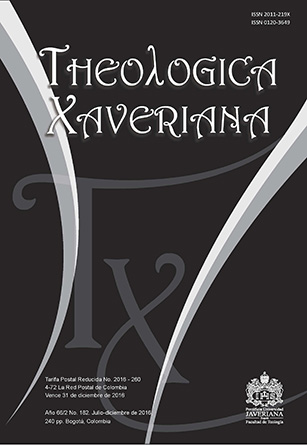Abstract
The book of Revelation describes the “final Paradise” as an environment in which certain “realities” of the present existence will be suppressed, among them, night time, whose abolition has been related throughout the Middle Ages to the suppression of time-inferred from certain interpretation of Rev 10:6. Based on the medieval reception of revelation, this article intends to analyze to what extent the supposed end of the night and of time can be associated, either by the elements found in the biblical sources or by the common structures of imaginary and of perception.
Alighieri, Dante. La divina comedia. Vol. II. Versión castellana de Enrique de Montalbán. Paris: Garnier Hermanos, 1920.
Brosse, Olivier (dir.). Diccionario del cristianismo. Versión castellana de Alejandro Esteban Lator Ros. Barcelona: Herder, 1974.
Comision Episcopal Española de Liturgia. Liturgia de las horas o nuevo oficio divino reformado según los decretos del Concilio Vaticano II. Vol. I. Laudes, Hora Intermedia, Vísperas, Completas (Diurnal). Madrid: Secretario Nacional de Liturgia, 1972.
De Bingen, Hildegard. Scivias: conoce los caminos. Traducción de Antonio Castro Zafra y Mónica Castro. Madrid: Trotta, 1999.
Delumeau, Jean. Historia del Paraíso. Vol. III. ¿Qué queda del Paraíso? Traducción de María del Pilar Ortiz Lovillo. Madrid: Santillana, 2005.
Durand, Gilbert. Las estructuras antropológicas del imaginario: introducción a la arquetipología general. México: Fondo de Cultura Económica, 2006.
Eliade, Mircea. El mito del eterno retorno. Traducción de Ricardo Anaya. Madrid: Alianza-Emecé, 2006.
_____. Imágenes y símbolos: ensayos sobre el simbolismo mágico-religioso. Versión española de Carmen Castro. Madrid: Taurus, 1989.
_____. Tratado de historia de las religiones. México: ERA, 1972.
Escola Bíblica de Jerusalém. A Bíblia de Jerusalém (ed. rev.). São Paulo: Paulus, 1995.
Evdokimov, Paul. L’art de l’icône: théologie de la beauté. Paris: Desclée de Brouwer, 1972.
Forte, Bruno. As quatro noites da salvação. Traducción de Antonio E. Feltrin. São Paulo: Paulinas, 2012.
Jankélévitch, Vladimir. La musique et l’ineffable. Paris: Seuil, 1983.
_____. “Le nocturne”. En La musique et les heures, por V. Jankélévitch, 226-268. Paris: Seuil, 1988.
_____. Le pardon. Paris: Aubier Montaigne, 1967.
_____. Philosophie première: introduction à une philosophie du “presque”. Paris: Quadrige/PUF, 1953.
Lurker, Manfred. Dicionário de figuras e símbolos bíblicos. Tradução: João Rezende da Costa. São Paulo: Paulus, 1993.
Maldonado González, Concepción (dir.). Clave. Diccionario de uso del español actual. Prólogo de Gabriel García Márquez. Madrid: SM, 2000.
Prigent, Pierre. O Apocalipse. Traducción de Luiz João Baraúna. Supervisión exegética de Johan Konings. São Paulo: Loyola, 2002.
Pseudo-Dionisio Areopagita. Obras completas del Pseudo-Dionisio Areopagita. Edición preparada por Teodoro H. Martin, presentación por Olegario Gonzalez de Cardenal. Madrid: Biblioteca de Autores Cristianos, 1990.
Salgado Gontijo Oliveira, Clovis. “Hora ambígua: significações e valores da noite cristã”. Ponencia presentada en el V Simpósio Literatura – Provocação para o pensar, Faculdade Jesuíta de Filosofia e Teologia, Belo Horizonte, septiembre de 2009.
San Juan de la Cruz. Obras completas (7a. ed. preparada por Eulogio Pacho). Burgos: Monte Carmelo, 2000.
Saville, Jonathan. The Medieval Erotic Alba: Structure and Meaning. New York- London: Columbia University Press, 1972.
Talmud. “Tractate Avodah Zara: Chapter 1”. Jewish Virtual Library, http://www. jewishvirtuallibrary.org/jsource/Talmud/avodazara1.html (consultado el 21 de abril de 2015).
This journal is registered under a Creative Commons Attribution 4.0 International Public License. Thus, this work may be reproduced, distributed, and publicly shared in digital format, as long as the names of the authors and Pontificia Universidad Javeriana are acknowledged. Others are allowed to quote, adapt, transform, auto-archive, republish, and create based on this material, for any purpose (even commercial ones), provided the authorship is duly acknowledged, a link to the original work is provided, and it is specified if changes have been made. Pontificia Universidad Javeriana does not hold the rights of published works and the authors are solely responsible for the contents of their works; they keep the moral, intellectual, privacy, and publicity rights.
Approving the intervention of the work (review, copy-editing, translation, layout) and the following outreach, are granted through an use license and not through an assignment of rights. This means the journal and Pontificia Universidad Javeriana cannot be held responsible for any ethical malpractice by the authors. As a consequence of the protection granted by the use license, the journal is not required to publish recantations or modify information already published, unless the errata stems from the editorial management process. Publishing contents in this journal does not generate royalties for contributors.



